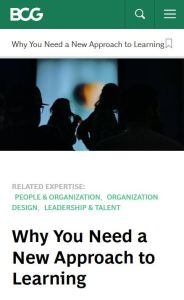
Jens Baier, Elena Barybkina, Vinciane Beauchene, Sagar Goel, Deborah Lovich and Elizabeth Lyle
Why You Need a New Approach to Learning
Boston Consulting Group, 2020
What's inside?
COVID-19 is either propelling your company into the future, or into the dustbin. Workplace learning will decide which.
Recommendation
There’s a fissure in your company. That crevasse will swallow your company if you let it. It’s the gap between what your employees know, and what they need to know to help your company thrive in the future. Your employees need digital skills, and trainings won’t get them where they need to go – especially with COVID-19 accelerating the process of digital transformation. The situation requires a more flexible approach to workplace learning, and the experts at Boston Consulting Group explain how to implement the necessary measures.
Take-Aways
- COVID-19 is propelling companies into the digital future.
- Guide your employees as their jobs require new skills.
- Incorporate workplace learning into everyday work.
- Nudges and incentives play an important role in workplace learning.
Summary
COVID-19 is propelling companies into the digital future.
Even before the 2020 pandemic, workplace learning was the top priority for forward-looking CEOs. COVID-19 has accelerated digital transformation and pushed employees into online work.
“Because skills go out of date so quickly, companies need to start thinking of workforce planning as an ongoing process rather than something they only have to do every few years.”
This trend will likely continue after the crisis has passed, and employees will require a brand-new digital skill set. Workplace learning needs to take place at employee level and be ongoing.
Guide your employees as their jobs require new skills.
Recognize your company’s skill gaps. Then support your employees as they acquire new skills, hire new talent, automate processes and consider outsourcing. These efforts should reach everyone – including:
- Senior executives who will set an example for others;
- Managers who must embrace agile, data-based action;
- Digital talent who will need to constantly update their skills;
- Employees whose jobs will require more digital skills; and
- Workers who need to learn new skills to prepare them for different roles.
Truck drivers, for example, will need to reskill when autonomous vehicles disrupt their jobs. These employees can maintain employment by taking on new roles: With proper training, they might thrive as robotics mechanics, for example.
Incorporate workplace learning into everyday work.
Microsoft managed to go from a “know it all” to a “learn it all” organization under the leadership of Satya Nadella. Gaining new skills necessitates applying them in day-to-day situations, receiving feedback and learning through trial and error.
“Building knowledge requires focus, practice, coaching, and the forming of new attitudes, all of which take months.”
Such learning starts with a change in perspective. Traditionally, workplace learning was an event that workers participated in sporadically in addition to their usual work. Now, workplace learning is part of the job. Formal trainings will still have their place, but daily learning is a must.
When an ant discovers a new food source, it guides others toward it until the entire colony knows the source. This so-called tandem running can also work for your company: Match a knowledgeable employee with one who needs to learn a new skill. Eventually, the student becomes the teacher for the next employee.
“The companies that embed learning into their operations and culture will create the workforce they need in order to thrive in the post-pandemic economy.”
You don’t have to hire from outside to acquire new skills. Existing employees can move around within the company to expand their skill sets, trying on multiple roles in different departments. Create opportunities for employees to reflect and share insights about which new ways of working are successful.
Nudges and incentives play an important role in workplace learning.
Push notifications can help employees remember new skills at the right moment; as can training programs that show up alongside new software applications. To emphasize the importance of learning, managers should ask team members regularly what skills they’re honing rather than simply what they’re working on. Daily reflection can help employees pinpoint what areas still require change or progress. Company leaders can bolster learning efforts by sharing their own development of new skills.
“Every step of an employee’s career path should include skill building, with time given to acquire knowledge, practice new skills, and reflect on and reinforce what has been learned.”
Examine how learning influences revenue, profits and the development of new products. Naturally, promotions and bonuses create the strongest incentives, so employees should know that learning new skills will lead to both. Employees might even benefit from a more holistic “learning ecosystem” that includes mindfulness training and other topics that are seemingly unrelated to their daily work.
About the Authors
Jens Baier, Elena Barybkina, Vinciane Beauchene, Sagar Goel, Deborah Lovich and Elizabeth Lyle collaborated on this special workplace learning report from Boston Consulting Group offices in Düsseldorf, Dallas, Paris, Singapore and Boston.
This document is restricted to personal use only.
My Highlights
Did you like this summary?
Read the articleThis summary has been shared with you by getAbstract.
We find, rate and summarize relevant knowledge to help people make better decisions in business and in their private lives.
Already a customer? Log in here.





















Comment on this summary